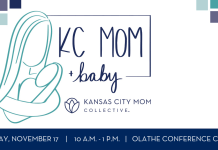This post is sponsored by HCA Midwest Health.
In late July 2023, I was sitting in a meeting at work when suddenly it felt like I had peed my pants. Just four months earlier, I had learned that at age 35 I was pregnant with my second child. But, I still couldn’t believe I was already losing bladder control so early in the pregnancy.
After the meeting, I didn’t give the episode much thought and continued working the rest of the day. When I got home that night, I started watching a movie with my toddler, and once again I felt a rush of water. “You’ve got to be kidding me,” I told myself. “There’s no way I just peed my pants again.”
High Risk Pregnancy
Because of my age, this was considered a high-risk pregnancy, so my OB/GYN, Dr. Susan Ezell, referred me to Dr. Jessica Parrott, a maternal and fetal medicine doctor who specializes in high-risk pregnancies. At my 20-week appointment, Dr. Parrott said the test results had come back normal and everything was progressing nicely.
However, on the night I peed my pants for a second time in one day, I called my mom for a little parental reassurance that everything was normal. Needless to say, I was shocked when mom said she was on her way to take me to the hospital and dad would stay at my house with my son. I called my husband at work to reassure him that this was just a precaution, and everything was fine. At this point, I was still convinced I had simply peed my pants.
When we arrived at Menorah Medical Center – a part of HCA Midwest Health, I was sent directly to the Labor and Delivery Unit. The maternity team began monitoring me and everything seemed normal with the baby. But, the test results came back positive for leaking amniotic fluid. The mood quickly shifted from light-hearted to shock as I realized my water had broken at 21 weeks. That’s when the doctor told me I would not be going home that night.
Everything was a blur
I was transferred by the HCA Midwest Health Maternal Transport team to Overland Park Regional Medical Center (OPRMC) and placed in their Antepartum Unit, which a nurse kindly described as “the place where we try to keep the babies inside as long as possible.” This is where I would spend the next two and a half weeks waiting to deliver. The first night I was put on magnesium, which helps protect the baby’s brain. The medicine made me nauseous and dizzy, but knowing how important it was for my baby’s welfare, I was more than willing to suffer through the side effects.
There was an overwhelming amount of information for us to digest the next day. I was very confused about why my water had broken so early. “Since I’m leaking amniotic fluid how do I replenish it, and can we make it stop leaking?” I asked only to find out you can’t really replenish it, and there was no way to make it stop. I asked if my baby could potentially go full term, but they said the risk of infection for me could possibly increase if we waited longer, so my focus turned to keeping my baby inside me for the next 10 weeks to get her to 32 weeks. At this point reality hit hard as I started to comprehend the magnitude of the situation. Little did we know at the time how challenging the next few months would truly be.
Everyone at OPRMC did an amazing job decreasing my stress levels and helping me make the best decisions possible for myself and my baby. The nurses and doctors gave me a ton of information, and they all took their time to make sure I understood everything. Tiffany, our social worker, was a godsend! Every few days, she would check to see how I was doing. She gave me all the information I needed about the Level III NICU, the Ronald McDonald Family Room and anything else she thought I would find helpful.
Emma Enters the World at 1 Pound, 11 Ounces
On the evening of Aug. 16, I asked my nurse if my monitors were showing I was having contractions. Sure enough, I was having contractions. They tried to slow the contractions to stop the labor, and I was put back on magnesium. They told me to call my husband because the baby was going to be delivered soon. I labored for six hours and at 7:30 a.m. the next day, Emma entered the world at 1 pound, 11 ounces and was immediately rushed to the NICU. 
Following the delivery, they wheeled me up to the NICU so I could see my little girl for the first time. I was so grateful that I was able to be in the same hospital with Emma. I was told by the nurses and doctors to prepare myself because the next few months would be full of ups and downs. Emma was considered a micro-preemie – a baby born before 26 weeks – so they put her in the Small Baby Unit, which is designed for babies born less than 29 weeks gestation. She couldn’t breathe on her own because her lungs were not fully developed, so they started her on oxygen knowing she would most likely be on it for the rest of her stay. 
I was heartbroken when I had to leave Emma in the NICU when I was discharged three days later. Since I had a toddler at home, I couldn’t make it to the NICU every day, but the nurses and doctors were beyond amazing. They would call daily with updates even if nothing had changed. The level of care Emma received was phenomenal.
Two weeks after Emma was born, we had another shock when she was diagnosed with patent ductus arteriosus (PDA). We met with Pediatric Surgeon Dr. Corey Iqbal who explained Emma’s condition and treatment plan. PDA is an extra blood vessel found in babies before birth or just after birth. In most babies who have an otherwise normal heart, the PDA will shrink and close on its own in the first few days of life. If it stays open longer, it may cause extra blood to flow to the lungs. Our plan was to treat it with steroids to see if it closed. In Emma’s case it stayed open, causing some of the blood that should go from the heart to the body to go to the lungs instead.
This meant tiny 1-month-old Emma would have to undergo PDA ligation surgery. My husband and I were terrified, but Dr. Iqbal calmly explained everything in a way that we understood answering all our questions. The surgery only took an hour, but it felt like the longest 60 minutes of my life. We were greatly relieved when Dr. Iqbal told us everything went exactly as planned and Emma wouldn’t need any follow-up.
After her surgery, the goal was for Emma to be as medically boring as possible; gain weight and lower her oxygen. Over the next few weeks her tests and scans kept coming back normal, and I could hold her as frequently as I wanted. I got to help with her care time, which made me feel more connected to her.
102 Days Later
I was starting to count down the days until we could bring her home, but in October Emma was diagnosed with stage three retinopathy, a condition that affects the blood vessels in preemies’ eyes. Doctors said Emma might possibly develop normal vision with no medical intervention, or she could end up with vision loss. The most grueling part was that we would have to simply wait and see how her eyes matured. Emma also failed a hearing test, but we soon learned the exam was pass/fail and it just meant that she would need to consult with an auditory specialist once she got out of the NICU.
I left the NICU that day feeling very defeated, wondering what these two tests would mean for Emma’s future. But one thing is for sure, she’s a fighter. Emma continued to make great progress as her days in the NICU rolled by. Just two days before Thanksgiving, the hospital called with the news that she might be released the following week. We immediately went to work getting ready. We learned how to use an oxygen tank at home. We roomed in with her at the hospital to learn how to read an oxygen monitor and oxygen tanks. At that point, our little girl had been in the NICU for more than 100 days.
Finally, after 102 days in the NICU, Emma was ready to make her great escape from the hospital on Nov. 26, 2023. I’m pleased to report she is now 7-months-old, off oxygen and no longer has retinopathy. She has some vision issues but those can be corrected with glasses. She also had her first hearing test, and while there were some delays, she could still grow out of them and hear perfectly. Most important, she continues to thrive.
She has some vision issues but those can be corrected with glasses. She also had her first hearing test, and while there were some delays, she could still grow out of them and hear perfectly. Most important, she continues to thrive.
The one thing I learned from this whole experience is never be afraid to ask questions. The doctors and nurses at Overland Park Regional Medical Center were beyond amazing. They answered every question thoughtfully and thoroughly. Thank you to the dedicated teams at OPRMC for taking care of me and my daughter.
Stacey Krivena is a mom of two and lives in Lee’s Summit, Missouri.
HCA Midwest Health delivers over 5,000 babies each year—more than any other hospital system in the Kansas City region. With four labor and delivery hospitals – Research Medical Center, Centerpoint Medical Center, Overland Park Regional Medical Center and Menorah Medical Center – across the Kansas City region, HCA Midwest Health makes it convenient to receive expert pregnancy and childbirth care. Find an OB/GYN or midwife at hcamidwest.com/delivers.
















